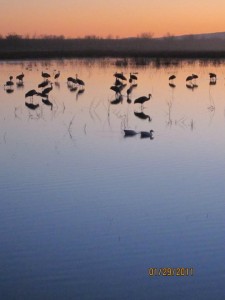The Fifth Circuit Court of Appeals reversed a lower court decision last week in Aransas Project v. Shaw, an important case involving claims that the TCEQ’s issuance of water rights permits violated the Endangered Species Act.
Background
In 2008 and 2009, 23 whooping cranes, which are considered endangered under the Federal Endangered Species Act, allegedly died in the Aransas National Wildlife Refuge. This information was based on a survey by biologists. Only four carcasses were actually located.
In 2010, The Aransas Project, and environmental group filed suit claiming that the birds’ deaths were caused by the TCEQ’s issuance of water use permits allowing people to divert water from the rivers feeding the Refuge. This action, argued the plaintiffs, resulted in less water in the preserve, which in turn increased the salinity of the water, which killed blue crabs and wolfberries living in the water, upon which the whooping cranes fed, all culminating in the death of the whopping cranes. Plaintiffs argued that because the cranes are an endangered species, their death constituted an impermissible take under the Endangered Species Act.
In 2013, a trial court judge found that the TCEQ’s issuance of permits on the rivers feeding the estuary violated the Endangered Species Act and barred the TCEQ from issuing additional permits for water use from the rivers. The Aransas Project sought and was granted an injunction prohibiting TCEQ from issuing new permits to withdraw water from rivers that feed the Refuge where the cranes make their winter home.
Fifth Circuit Decision
The three-judge Fifth Circuit panel reversed. [Read full opinion here.] As stated by the court, the key issue in this case is “whether the actions of TCEQ in administering licenses to take water from the Guadalupe and San Antonio rivers for human, manufacturing and agricultural use foreseeably and proximately caused the deaths of whooping cranes in the winter of 2008–2009.”
The court found that the lower court failed to adequately determine whether the TCEQ’s actions were the cause of the cranes’ deaths. In discussing the lower court’s opinion, the Fifth Circuit noted, “nowhere does the court explain why the remote connection between water licensing, decisions to draw river water by hundreds of users, whooping crane habitat, and crane deaths that occurred during a year of extraordinary drought compels Endangered Species Act liability.” The opinion continued, “[t]here is a long chain of causation here between the TCEQ’s issuance of permits to take water from the rivers and cranes’ mortality…Every link of this chain depends on modeling and estimation. Proximate cause, however, requires the causal factors and the result to be reasonably foreseeable.”
Thus, in conclusion, the court stated, “[b]ecause the deaths of the whooping cranes are too remote from TCEQ’s permitting withdrawal of water from the San Antonio and Guadalupe Rivers, the state defendants cannot be held liable for a take or for causing a take under the ESA.”
The Aransas project now has 14 days to determine if it will seek rehearing before the entire 5th Circuit and 90 days to determine whether it will appeal the ruling to the United States Supreme Court.













